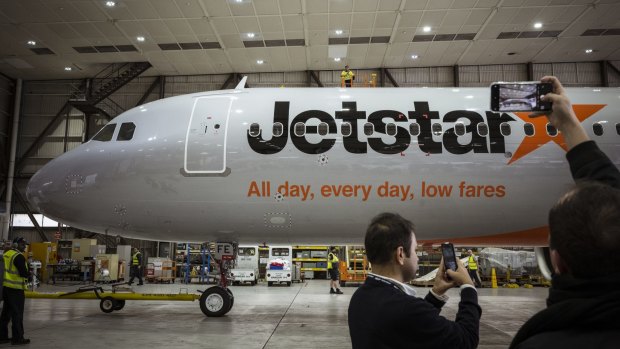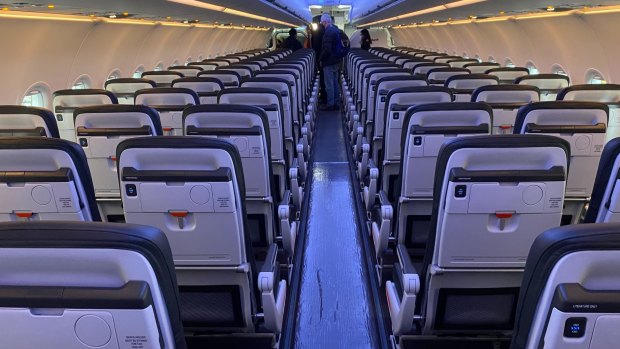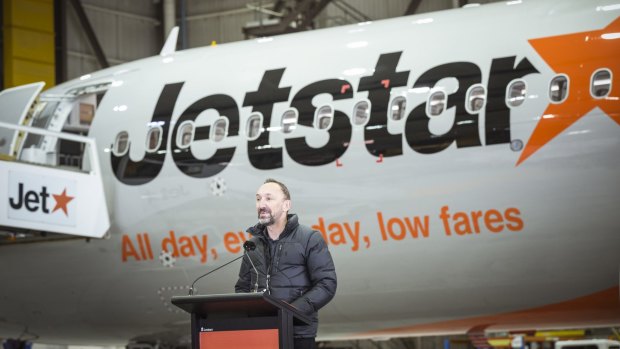This was published 1 year ago
Jetstar Airbus A320neo: First A321neo LR delivered, promising larger seats, longer range
By Craig Platt

Jetstar's first Airbus A321neo LR arrives at the airline's hangar in Melbourne.Credit: Chris Hopkins
Bigger seats, larger overhead bins and a quieter cabin are what passengers can look forward to when flying on Jetstar's newest plane, the Airbus A320neo.
Eleven years after ordering the plane, Jetstar's first A320neo touched down on Sunday at Melbourne Airport, after making its way from Hamburg, Germany, via Mumbai and Perth.
The jet, an A321neo LR (long range) variation of the A320neo, arrived to a crowd of Jetstar employees and their families with INXS's New Sensation blasting throughout the hangar.

Jetstar Airbus A321neo LR features an all-economy class configuration with 232 seats.Credit: Craig Platt
The jet's engines are 15 per cent more fuel efficient than Jetstar's current A320 fleet, and it is 50 per cent quieter and can fly up to 1200 kilometres further.
Fuel efficiency is a key selling point for Airbus ("neo" stands for "new engine option"), as airlines look to reduce emissions and fuel costs amid soaring oil prices.
"Even if the price of oil hadn't changed, it's essential," said Jetstar chief executive Gareth Evans. "The biggest challenge for the industry as a whole over the next decade and the decades beyond is sustainability.

Jetstar chief executive Gareth Evans speaks at the arrival event.Credit: Chris Hopkins
"We've recognised that, as the Qantas Group, with some of the most ambitious targets out there – 25 per cent reduction in emissions by 2030 and zero emissions by 2050. The neo is part of that journey along with sustainable aviation fuels."
Watch: The construction of Jetstar's first A321neo LR
Evans said Jetstar had made other changes to the neo to reduce weight and fuel costs. There are lightweight galley carts and freight containers, and even the plane's paint has been developed to lighten the load. The new paint cuts weight by 50 kilograms and, combined with other changes, removes 170 kilograms from every flight.
"This translates to a saving of 1.2 million kilograms of fuel annually, a reduction of almost 4000 tonnes of emissions," Evans said.
He said Jetstar was operating roughly the same number of flights as before COVID, amid soaring passenger demand.
"We're trying to manage supply, demand and obviously the impact of the fuel bill, so we have taken some capacity out," he said. Reducing the number of seats available increases the loads on other flights, making them more cost-effective.
The A321neo LR is the widest single-aisle plane on the market, with Jetstar's 232 economy seats on board offering seat pitch (leg room) of 74 centimetres, and 45.7 centimetres of width. That's the same leg room as on other Jetstar domestic aircraft, but a marginally wider space.
Passengers will also have 40 per cent more space in the overhead bins, device-holders built into seats and a streaming entertainment service.
Unlike the airline's Boeing 787 Dreamliners, there will be no business class.
"Primarily, these planes will be flying domestically," Evans said. "This is an aircraft that is going to be able to move between the two networks [international and domestic], but at the same time we've made sure we've got good seat pitch and elements that improve customer comfort."
The aircraft will first be deployed on the Melbourne-Cairns route in early September, before rolling out to other domestic routes and some international destinations including Bali.
Jetstar has ordered 38 of the A321neos. The first 18 are to arrive in the next two years, followed by 20 longer-range versions by 2029. Airbus has received 8100 orders from more than 130 customers worldwide for the plane. About half the A321neo fleet will be based in Melbourne, Evans said.
See also: World's largest twin-engine jet makes incredibly steep take-off
See also: Superjumbo comeback: The airlines still flying A380s to Australia
Sign up for the Traveller newsletter
The latest travel news, tips and inspiration delivered to your inbox. Sign up now.